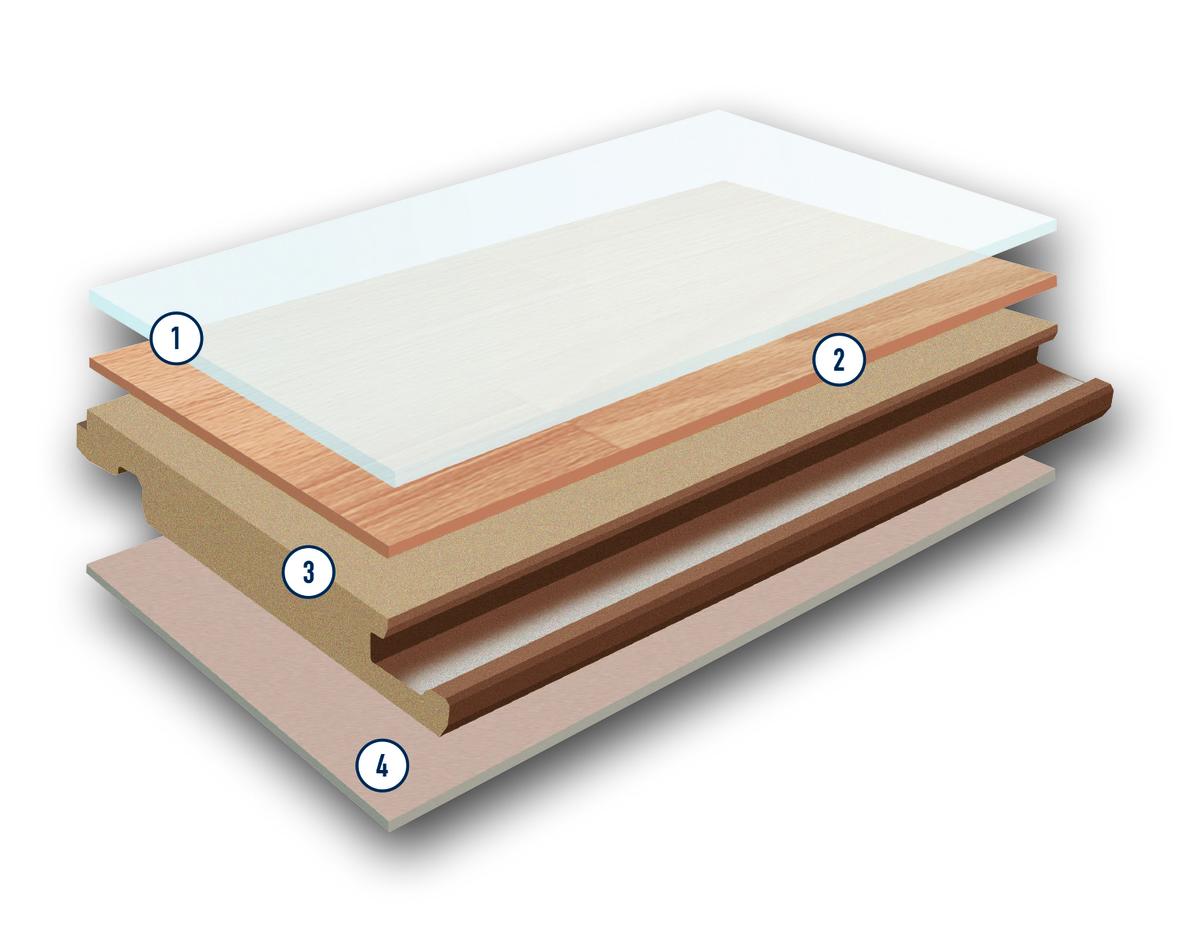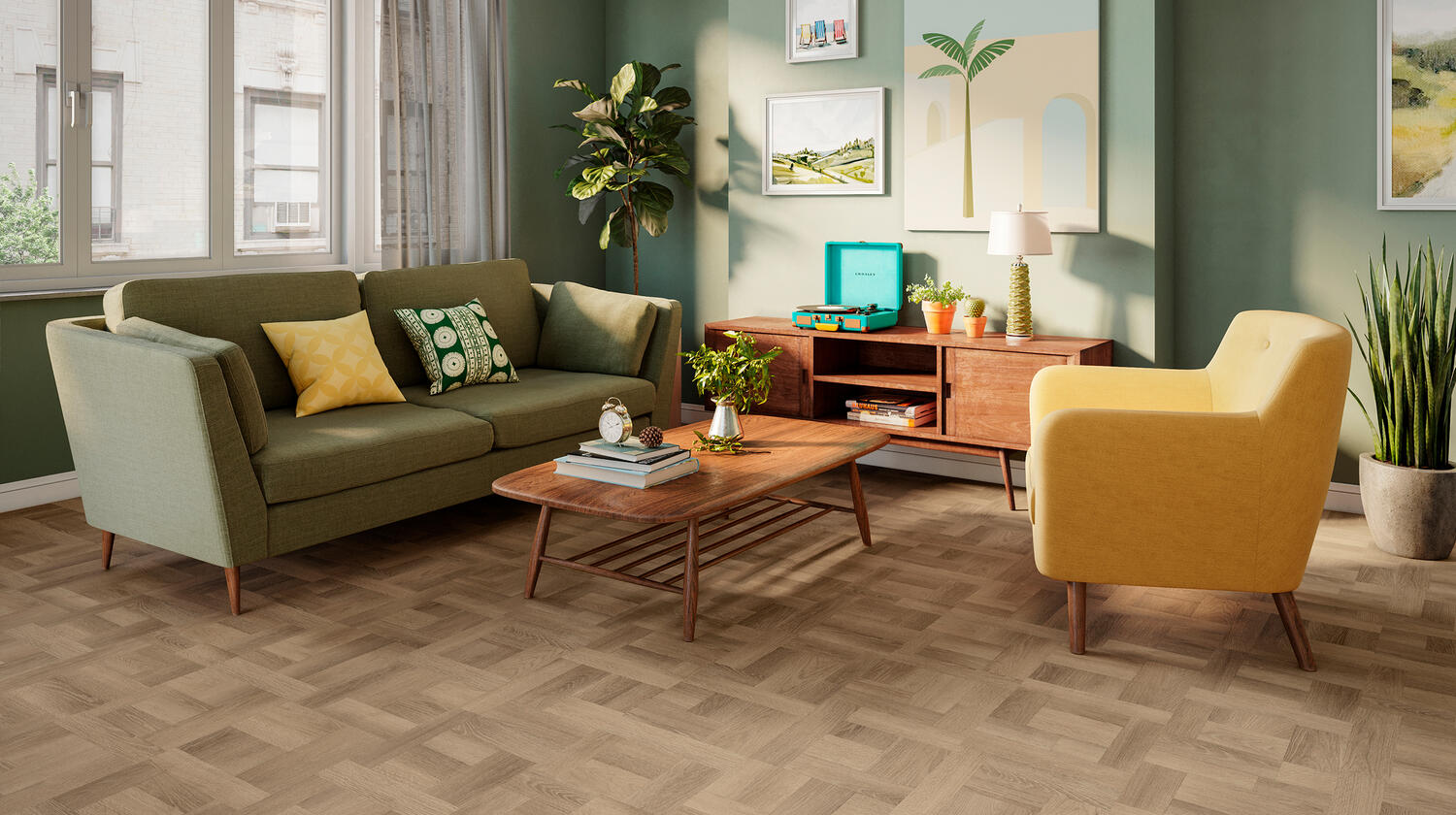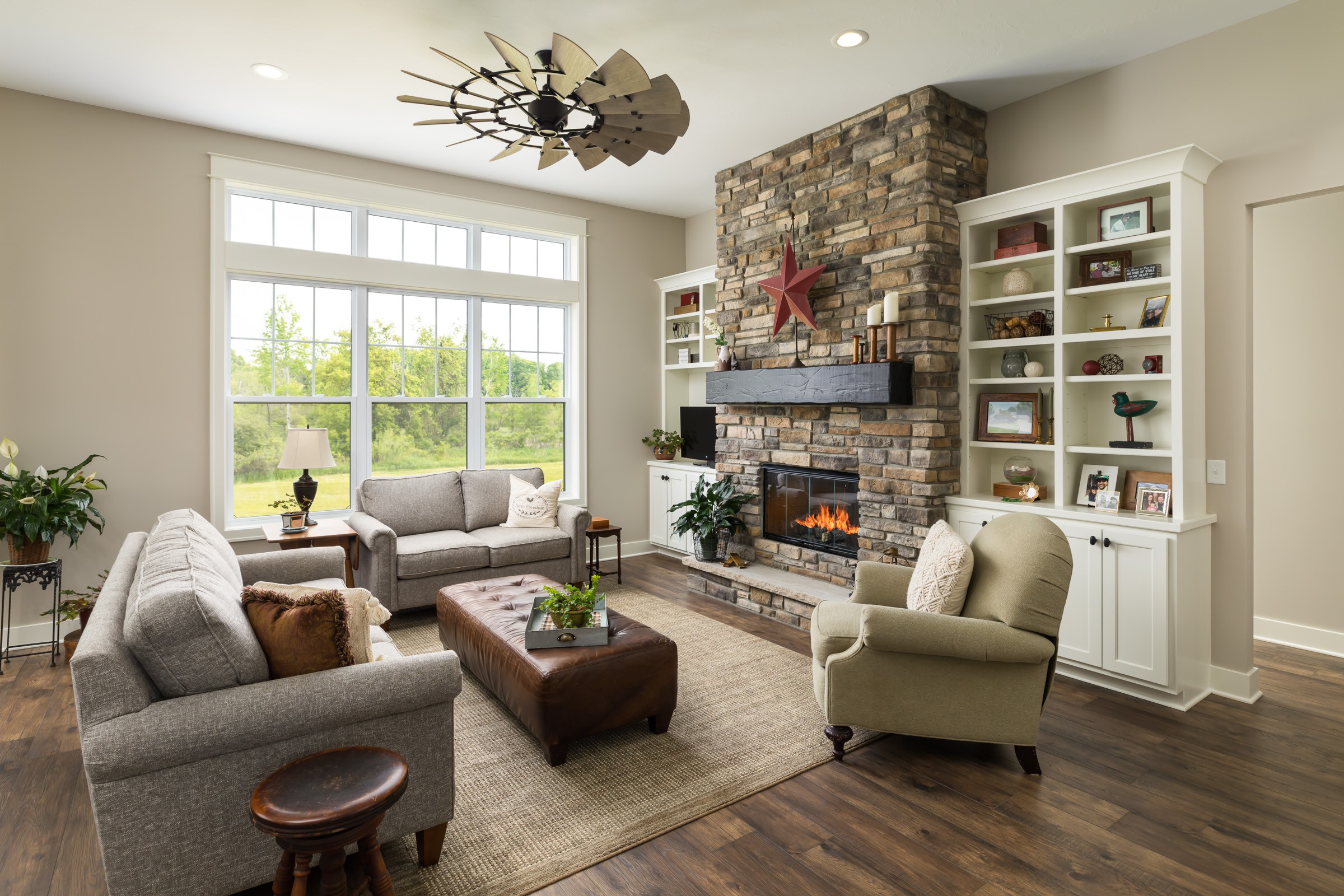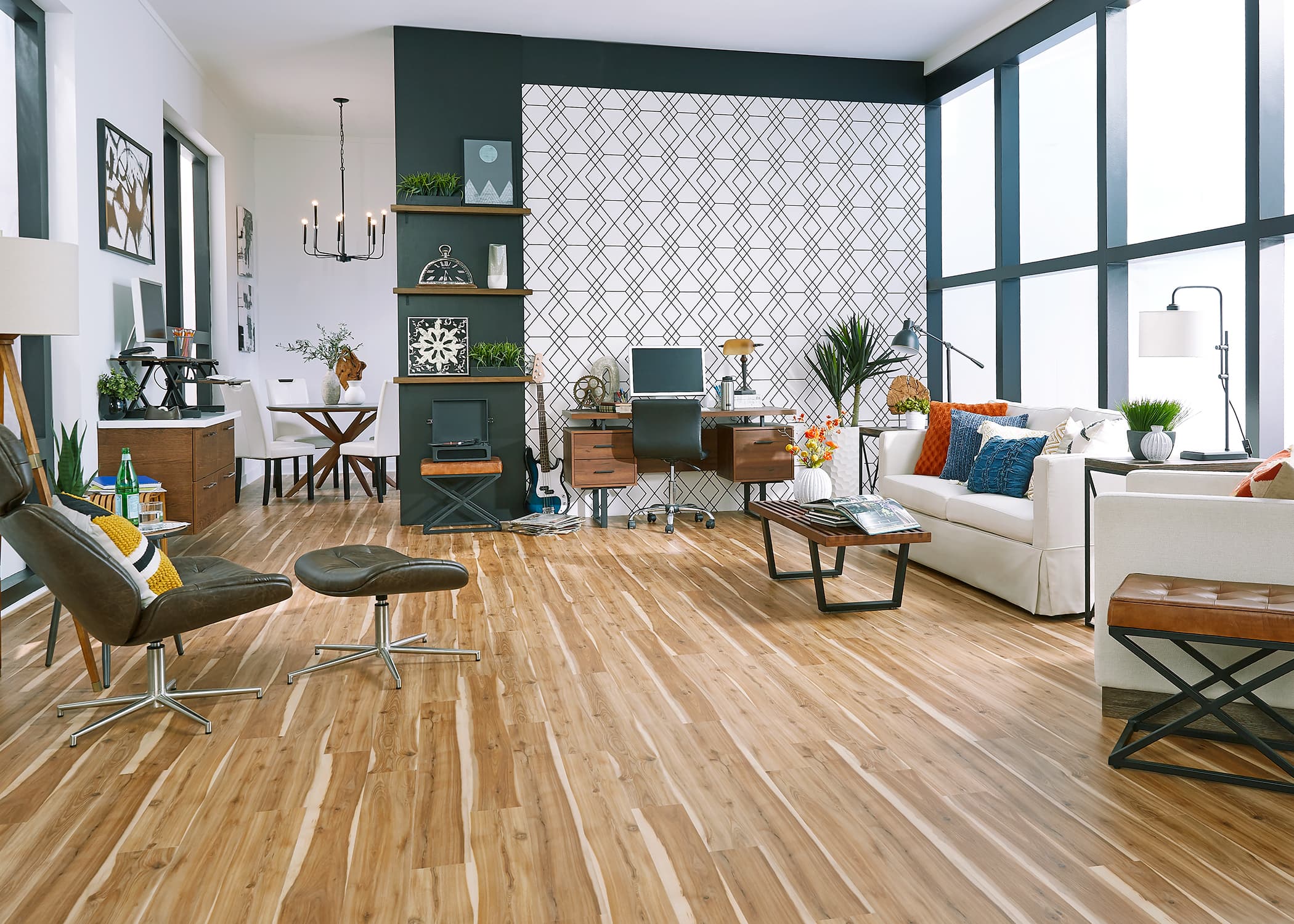A laminate floor is a synthetic product made up of multiple layers that are sealed together during the laminating process. The benefits of laminate flooring include high durability, easy installation, and maintenance, as well as the beauty of traditional hardwood, stone, and tile floors. It is the purpose of this guide to provide a comprehensive overview of different types of laminate floors so that you may select the one that is most appropriate for you. We will also provide you with basic installation and maintenance tips to ensure your new laminate flooring is installed and maintained properly.
Please enjoy this guest post on all things laminate flooring (thanks Angela!)

Photo: InHaus
The Basics of Laminate Floors
Floor laminates are hybrid flooring products composed of a HDF particleboard wood base with an image layer and a clear wear layer on top. For homes' living areas, kitchens, dining areas, bedrooms, and hallways that aren't exposed to excessive moisture, laminate floors are one of the most popular types of flooring.
The first laminate flooring was developed by the Swedish company Perstorp in 1977. It was proposed that waste wood projects could be used by exposing them to high pressure, heat, and binders. Ultimately, this resulted in beautiful and usable floor coverings. Since then, many other manufacturers have produced laminate floors, including Krono Group, Mannington, Armstrong, Unilin Mohawk and Shaw.
The Materials of Laminate Flooring
A laminate floor is sometimes referred to as a laminate wood floor, despite only being made from wood in two respects: the base material and the appearance.
First of all, the laminate floor is constructed from pressed chipped wood particles (HDF). Secondly, the top reproduces the appearance of real wood thanks to the accurate image layer, which is composed of a well-rendered photograph of wood within a durable, clear coating. The surface often has realistic texture as well, making many laminate flooring difficult to tell they aren't real hardwood floors.
High pressure is applied to aggregated wood particles in order to form sheets. On the top of these sheets is an image of wood or stone that is photorealistic, and this image is covered with a protective layer that protects the image. Basically, the wear layer is a thin, clear plastic sheet that serves as a barrier between the delicate lower layers of the product and external factors such as moisture, ultraviolet rays, or scratches.
The Components of Laminate Flooring

Photo: Tarkett
Laminate flooring is comprised of four distinct components designed to be affordable and durable.
Laminate Floor Wear Layer
There are two thin layers of paper impregnated with melamine that make up laminate flooring. In the uppermost layer of the plastic, there is a hard transparent sheet that is resistant to dogs, chairs, high heels, and other common objects that may damage the surface. The wear layer eliminates scratches caused by ordinary wear, provides an easy-to-clean surface, and ensures that the appearance of the surface will not fade or stain over time.
Laminate Floor Image Layer
A décor layer replicates the look of wood, tile, or stone by printing a photo image over the top. The appearance of laminate flooring can be convincing even when viewed from a close distance. This is because the laminate image underneath the wear layer is photographic quality, thereby creating the illusion of real wood. The quality of many laminate floors in the market today are incredible.
Laminate Floor Base Layer (Core)
Laminates are structurally strong, high scratch resistance and pretty high dent-resistance. The durability of laminate flooring is much greater than the durability of solid hardwood flooring, many due to that top layer that avoids scratches (depending on AC rating, see below).
There is about 3/8th to half an inch of wood-chip composite beneath the wood-grain photograph. It is inherent to all types of wood chip products to be susceptible to water damage. Dimensional stability is considered to be a characteristic of laminate flooring but to a limited extent. In most cases, laminate flooring is resistant to some level of moisture, provided that it is removed as soon as possible.
Laminate Floor Backer Layer
Additional support and stability are provided by the final backer layer
Laminate Flooring: What You Need to Know

Photo: Builddirect
Choosing the right laminate for your home requires consideration of these key features.
The Thickness of Laminate Flooring
Typically, laminate flooring is available in thicknesses between 6 millimeters and 15 millimeters (6mm to 15mm). Be aware that some manufacturers include the thickness of the laminate product with the core and attached pad when comparing laminate products. A laminate is designed to resist denting to a similar degree. Laminates with a thicker composition are better suited to withstand bending caused by uneven subfloors and reduce noise. Most popular thickness is 8mm and 12mm.
The thicker the product the more solid it feels under foot. But, in our extensive testing, we see no performance difference between 8mm to 12mm thicknesses. These are the most common, with 8mm being the popular size from Europe and 12mm being most popular from Asian manufacturers.
The Width of Laminate Flooring
A laminate plank's width can range from less than 5 inches to 7.75 inches or more. Approximately 7" wide is the most common width for laminate floors.
The Visual looks on Laminate Flooring
There is a seemingly endless selection of options available, including oak, hickory, walnut, cherry, pine, maple and exotic species. Patterns and countless visual options. Some can look like an old barn, some a beach house, many are modern and clean. A trend in some regions of the world had laminate placed on the wall for a visual display, like a piece of art.
The AC Rating of Laminate Flooring
Wear resistance is measured on a scale of 2 to 5 based on the Abrasion Criteria (AC). The higher the AC rating, the more durable the product. The most common residential products are AC3, and a nice upsell option is the AC4 option. AC5 is extra durable and can be found in some styles, but it is less common. We have seen an AC6 produced, but this currently is extremely rare. The AC3 and AC4 options are really ideal for about 95% of residential applications.
Watch this video to know more about the 5 vital things you need to know about laminate flooring... ok, this is an oldie but a goodie! We know the guy that filmed it! Haha:
Types of Laminate Flooring
- There is a wide range of widths of laminate planks, ranging from less than 5 inches to 7 inches and beyond. More so, the thickness of laminate flooring varies from 6mm to 15mm, measured from the base to the top of the board for boards that do not include the underlayment. It is important to note that laminate flooring's thickness influences how much more impact-resistant and quiet it is when walked on. As thicker flooring is more easily installed on subfloors that have imperfections, it is also a benefit when dealing with subfloors with imperfections.
- The appearance and texture of laminate floors can often be compared to those of hardwood floors. In addition to styles that resemble stone, ceramic and porcelain tiles are available in various finishes.
- As the name implies, laminate wood flooring is composed of pressed composite wood overlaid with visual images of different types of wood to create a unique, yet familiar appearance. Its cost-effectiveness makes it an excellent alternative to real hardwood.
- Tiles and planks of laminate flooring give the appearance of stone or ceramic. The use of laminate flooring that resembles tile is becoming more common in residential spaces due to its ability to provide the same style at a lower cost.
- There are a variety of styles available for laminate flooring that is easy to install. The installation of a click-lock laminate floor is a relatively straightforward task, especially for DIY enthusiasts. A locking laminate flooring is manufactured with tongue-and-groove construction that makes it possible to snap and lock the planks into place. It is possible to walk on this type of laminate floor immediately after it has been installed.
- Generally, laminate floors are installed with thin underlayments, which make the floors feel softer underfoot and produce a realistic sound when you walk on them. There are some laminate flooring types that have a noise-resistance feature that can be useful to those who are looking for a quieter floor.
Floating floors, such as laminate, require a small expansion space around their perimeter to allow them to move with changes in humidity. If you would like to beautifully finish your room, you can cover this area with a coordinating wall base and quarter round.
The Textures of Laminate Flooring

Photo: EM Custom Flooring
To simulate real hardwood flooring, laminate flooring comes in many different textures and finishes.
- The smooth laminate flooring. This looks like smooth wood, or polished marble / ceramic tiles because it has no texture.
- Embossed / EIR : Laminate flooring that is embossed has a wood grain-like texture due to the pressed pattern. The term EIR is a high quality option that is a specialized procedure that matches the texture on the surface to the visual look. So if the picture on the laminate has an wooden knot, then the EIR texture will let you 'feel' the knot. EIR (embossed in register) is worth the investment, it adds value and makes there installed floor look more realistic.
- A hand-scraped laminate floor. This has the appearance of antique or distressed hardwood. Antique-inspired or vintage laminate floors are popular in homes that prefer a cabin / rustic style. Despite not actually being hand-scraped, the laminate is pressed to look just like hardwood floors with real hand-scraping.
- Low Gloss and High gloss laminate floor. This laminate floor finish vary in gloss level. Not currently very popular in Canada, the high gloss finish will give your floor more of a shiny look, while a low gloss finish will give your floor a matte appearance. Although matte floors do not differ in terms of durability, they tend to conceal small scratches more effectively than glossy floors.
- Embossed or Embossed in Register (EIR) laminate floor. By adding depth and texture in line with the design of the décor layer, EIR more closely mimics the natural appearance of hardwood flooring.
The Features Of Laminate Floors According To Room Type

Photo: Tarkett
A laminate floor has tight seams and prevents water from reaching the raw edges of the plank when it has been properly installed. As each plank is sealed on top and bottom, the material is highly water-resistant, making it ideal for wet areas such as kitchens and bathrooms.
Listed below are some of the most popular laminate floor characteristics:
- Laminate flooring that is waterproof or water-resistant can be an option for bathrooms, kitchens, and basements. The most popular bathroom flooring materials are vinyl and tile. Laminate flooring is an alternative to these materials that can be more affordable.
- It is ideal to install heated laminate floors in bedrooms, dens, and living rooms since they provide superior underfoot comfort. They are also an excellent choice for bathroom floors, particularly in areas surrounding the bath and shower.
- It is recommended that basement laminate flooring be installed with stronger water-resistance laminate flooring. It is also recommended to lay down a vapor barrier before installing laminate flooring and underlayment. By doing this, a leak will be prevented from damaging the subfloor.
The laminate flooring should not be left wet for a long period of time. It is important to clean up spills quickly on kitchen laminate flooring so that damage can be avoided. As mentioned in other parts of this article, the concern from spills is the risk to damage the laminate core, but, it is also the surrounding area. Walls and subfloor are not water resistant and cleaning up spills / leaks are soon as possible is obviously advised.
The Benefits of Laminate Flooring
It is a popular choice among DIYers to install laminate flooring. With so many improvements in quality and selection, it is a great deal better than it was just a few decades ago. In addition to these points, laminate flooring also offers the following significant advantages:
- The laminate flooring will last for many years. The price point allows them to be easily replaced when tastes or styles change.
- Laminate flooring is a great option for apartment dwellers or home owners that wish for a price point renovation. This is a great flooring type for rental tenants, as it looks good and is durable.
- The process of installing laminate flooring is fairly straightforward. Most DIYers can take this project on. It still takes skill, so ensure you are handy and have a plan, but this flooring type is the most common one that can be installed. And please, take your time and work on the subfloor first. A level subfloor is required to avoid future issues and voiding warranty. Basic tools needed to install laminate flooring: tape measure, a saw, a tapping block, and a hammer of soft mallet.
- DIYers can install laminate flooring over existing floors, which allows them to obtain an entirely new appearance without undergoing any heavy renovation. But, as mentioned, the subfloor (either over an existing floor or not) must be level.
- The benefits of laminate floors include their scratch resistance and ease of cleaning. It is for this reason that they are a much more attractive alternative to hardwood floors or carpets.
Laminate Floor Maintenance and Care

Photo: Angie's List
A laminate floor is easy to clean and maintain, making it a good option for high-traffic areas and family-friendly areas. The maintenance requirements for different laminate flooring types are also generally the same. Regardless of the style, you select, this provides a great deal of versatility and long-term durability.
You can maintain and care for many types of laminate flooring finishes with the following tips:
- All you will need to clean your home on a daily basis is a damp mop or duster. Spot cleaning of laminate floors is possible with laminate floor cleaners. There is no need to mop or wax wet.
- It is advisable to use door mats at exterior doorways in order to limit the wear and tear on the ground surface.
- It is is still very important to use floor protectors or casters on the legs of furniture in order to prevent scratches.
- Make sure liquids are not allowed to stand on the floor; wipe up spills as soon as possible. Even higher quality water resistant laminate flooring, avoiding standing water is important. The floor may be able to resist, but water will move and find its level, which could impact walls or subfloors, which are not water resistant.
- Laminate finishing pens can be used to cover small scratches and nicks.
Underfloor Heating for Laminate Flooring
Laminate flooring cannot be used with all types of underfloor heating. The mesh may need to be embedded in a thin-set or self-leveler prior to the installation of laminate-compatible systems. It is important to carefully read the product specifications and instructions before using the product.
Several laminate flooring options are available that are water-resistant. To ensure that your installation is water-resistant, you should carefully follow the installation instructions.
Installation Tools and Materials for Laminate Flooring
The installation of laminate flooring is referred to as a floating installation, which means it is not fixed to the subfloor by glue, nails, or staples. The installation is very DIY-friendly, but there are a few things you should keep in mind.
Underlayment for Laminate Flooring

Photo: Houzz
The installation of some products is made easier by the inclusion of an acoustical pad. Otherwise, you will have to install underlayment before you can proceed. The purpose of underlayment is to: allow for a floating floor, to provide moisture protection, and thermal insulation. This is also key to reduce sound. Whenever laminate flooring is installed over concrete subfloors, an underlayment with a moisture barrier is required in order to prevent the floor from expanding due to water passing through the subfloor. Follow the moisture protection instructions provided by the flooring manufacturer.
In some laminate flooring products, acoustical pads are already included. Although the attached pad is useful for making installation easier, it is not a moisture barrier. Follow instructions from the supplier.
Watch this video to learn more about laying laminate flooring:
Moulding Products for Laminate Flooring
Moulding/millwork pieces to match and coordinate include quarter rounds, T-mouldings, thresholds, reducers, and stair nosing (maybe even stair treads).
Laminate Flooring Tools
It is necessary to have a pull bar, tapping block, and spacers in order to install a laminate floor. Of course, a proper power saw. Using a chalk line to ensure first row is straight is also very beneficial.
Laminate flooring was introduced in the 1970s and consists of layers of synthetic material that are engineered to appear as though they are made from wood or stone. Having gained a reputation for affordability and durability, it quickly became a popular alternative to the real thing. The quality and appearance of laminate have improved greatly since it was introduced to the market, and there are more options than ever available today.
It is important to consider the pros and cons of laminate flooring in order to determine if this material is likely to meet your needs in terms of budget, lifestyle, and aesthetics.
Laminate Has Varying Degrees Of Durability And Resilience

Photo: Floor Covering Weekly
Knowing that laminate can’t be refinished naturally makes you wonder how long it lasts. Fortunately, there’s a highly durable wear layer above the image layer designed to withstand foot traffic, sun fading, scratches, dents, and stains. And if a piece does get damaged, you can often replace the individual plank. But in case you can’t pull up the unsightly plank, repairing a scratch or dent in laminate flooring can be tricky at best and impossible at worst.
Manufacturers assign each product an AC rating, which specifies the usage conditions it will withstand best. A product with a higher AC rating will be more durable. The following numbers should be kept in mind when choosing a product that can withstand the demands of your household and last for a long time:
- AC 2: Ideal for homes with medium foot traffic.
- AC 3: Ideal for high foot traffic areas at home, such as the foyer and kitchen.
- AC 4: Suitable for use in all traffic areas of the home and meets some light commercial applications.
- AC 5: Suitable for heavy traffic in commercial areas.
Laminate Installation Method
Since laminate floors use a modified tongue-and-groove method of joining boards, they install similarly to solid hardwood floors. However, laminate flooring is extremely easy to install using only basic tools, unlike hardwood flooring, which typically requires professional installation.
In general, laminate floors are installed as floating floors. Therefore, it does not present the same installation challenges as hardwood or engineered wood, such as nail-down installation. For a floating floor, you should first roll out an inexpensive foam underlayment and then tape it together. Next, you should lay out laminate planks on top of the underlayment.
A laminate floor plank can either be snapped together or glued together, depending on the type you purchase. Snap-together methods are often referred to as fold-and-lay or fold-and-lock.
Fold-and-lay joinery differs from tongue-and-groove joinery because it begins with two boards attached by outer grooves and angled to each other, rather than sliding one board into the next. The next step is to fold down one of the boards until it reaches the same level as its companion board. By using this folding mechanism, the two boards will be brought imperceptibly closer, thereby tightening their bond and preventing water from migrating between them.
Watch this video to learn more about laminate flooring installation:
Subfloor and Underlayment for Laminate Flooring
Laminate floors, like all flooring, require a sound, sturdy subfloor. In order to provide a softer footfall when walking on the laminate, foam or felt underlayment is placed between the subfloor and laminate.
There are instances when the subfloor does not meet the requirements for underlayment, an intervening underlayment can be installed above the subfloor and underneath the foam underlayment. It is important to ensure that the subfloor is level before installing laminate to prevent unsightly gaps between the boards.
I will say that again ... a level subfloor is vital. Top two reasons for problems with flooring is moisture (humidity) and unloved subfloors. Invest in levelling your subfloor!
There Is A Style To Suit Virtually Every Preference

Photo: LL Flooring
A laminate floor consists of a core layer topped by an image layer containing a digitally enhanced photograph of natural material. This will be able to replicate everything from exotic hardwoods to concrete and natural stone - this is a major advantage. A wide variety of colors, lengths, and widths are available, and, nowadays, the texture of the flooring can even be embossed to give it a more realistic appearance. Although some critics maintain that laminate cannot compete with the natural beauty of wood or stone, regardless of how high-end the product may be.
Other flooring blog articles you may want to read:
BIYORK FLOORS: BUILDING ON INNOVATION, BUILDING ON DESIGN
WHAT ARE THE DIFFERENT TYPES OF VINYL FLOORS?
FLOORING MADE BETTER BY TORLYS
LAMINATE, VINYL, AND ENGINEERED HARDWOOD FLOORING OPTIONS: WHAT MAKES THEM DIFFERENT?
